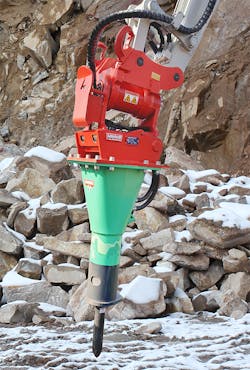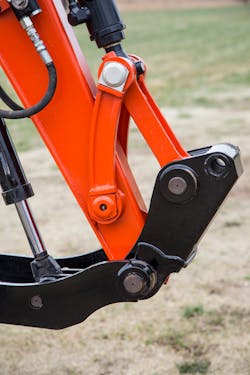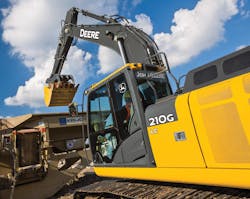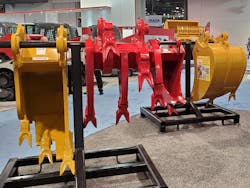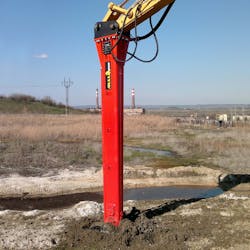Attachments are “absolutely required to get any work done,” claims Alex Anhalt, product consultant, excavators, John Deere. While that may be a slight exaggeration, excavator attachments can reduce the number of additional machines and laborers needed on a job site, freeing them up to be used elsewhere or on other jobs. “More work with one machine and one operator means more efficiency.”
Attachments provide an economical alternative to a labor-intensive function, John Goode, president of Maddock Construction Equipment LLC, explains.
Essential Attachments
Some of the attachments used on excavators to make them more productive are so efficient, they are considered essential. Jeff Jacobsmeyer, regional sales manager for Land Pride/Kubota-branded attachments, lists the basics: hydraulic thumbs, breakers, augers, tilt-angle buckets, and mowers.
Thumbs are probably the most common attachment for excavators because of their versatility, according to Anhalt. "They can be used to clear trees and brush, demolish buildings, move scrap, [and] precisely place rocks for rock walls." Depending on the geographical area and the job site, he continues, hammers are also common and are primarily used to break up rock for laying sewer and water pipe.
Edison Rocha of the Allu Group adds transformer screens and the AC Series crusher and processor to the list, noting that "the screeners are the most popular." Allu hydraulic attachments are designed to be used on different sizes of excavators in numerous applications for processing, separating, sorting, mixing, and crushing materials. Typical applications include soil and waste material recycling and processing contaminated soil. “The main reason [for] using them is to transform waste into usable material."
Additional Attachments
Most attachments are designed for a dedicated purpose. As John Wittenberg, product manager at BTI Breaker Technology, says, buckets dig, breakers break, pulverizers pulverize. “The most widely used attachments for an excavator are ground-engaging buckets and hydraulic breakers.” These two attachments allow for quick removal of ground material.
“Manhattan is one giant stone,” observes Tim Miller, US sales manager, Montabert—the first company to develop a fully hydraulic breaker. “New York is all granite; buckets won’t take it out.” Traditionally, if they hit rock, contractors have to drill and blast—which takes time—or use hydraulic breakers.
Montabert offers breakers that fit a 1-ton mini excavator to a 100-ton large excavator. Featuring automatic variable 15-speed technology, they adapt to the material. “Every strike determines the force of the next strike,” states Miller.
Suitable for many different applications, the breakers are “an important piece for preparatory work,” continues Miller, particularly in quarries when blasting is not the best option, but also for concrete recycling and bridge deck removal. “There is stone everywhere, but it’s not just rock. Breakers are used to demo concrete.” An example he gives is airport renovation. “Runways are massively thick and the concrete changes during a pour, so it fractures at different rates.”
An excavator mill attachment is popular with municipalities, claims John Goode, Maddock Construction Equipment LLC, because it enables them to cut asphalt to lay a steel plate for utility work more economically by using an excavator. "A diamond saw and jackhammer take hours. Our attachment takes minutes and grinds to a fine finish quickly and safely, with the operator remaining in the machine." Available in widths of 18 to 48 inches, it features proprietary bit and lacing patterns that are more durable, he says. A vacuum attachment and water tank mitigate dust.
Another way to get through rocky terrain is to use non-hydraulic rock rippers and ripping buckets from Leading Edge Attachments Inc. “People think you need a hammer to get through rock,” says Lee Horton, president, “but 95% of rock doesn’t need it. A ripper is four times faster.”
Pure bedrock granite and basalt need a hammer or blasting, but layered or weathered rock doesn't, he continues. "If you gouge with a corner tooth, you can rip weathered rock, layered rock, fractured rock, exposed rock, caliche, shale…" About 90% of their customers are utility contractors digging where the ground hasn't been dug before for water, sewer, and electric.
Leading Edge’s main products are the three-shank Multi-Ripper and Multi-Ripper Bucket, with three back and three front teeth that hit one at a time for full force. Suitable for excavators and backhoes, they are made of Hardox 450, a Swedish steel, with no cross members. “The material is harder than teeth, so some don’t even use teeth,” notes Horton.
A new high-production five-shank Multi-Ripper fits on a backhoe or mini-excavator, but Leading Edge is also working on a ripper for big buckets. “Getting the correct width of the trench saves time, energy, and fuel,” explains Horton, “so we are working on all widths and sizes.”
Multi-Use Attachments
For more specialized work, BTI has some multi-purpose attachments, such as its TC Series plate compactors, which are primarily used for area compaction of soil but can be quickly modified for use as pile drivers, and its RP Series rotary pulverizers, which can be used for both primary and secondary demolition of rebar-reinforced concrete slabs.
BTI’s MS Series hydraulic multi-processors with hydraulic rotation can complete a full range of demolition by changing out the jaws on the parent attachment. “Jaws include primary demolition concrete, combination shear and concrete cutter, secondary concrete pulverizer, general-purpose metal shear, plate steel shear, and rail cutter,” lists Wittenberg.
Leading Edge Attachments custom-manufactures rakes to fit different thumbs so the two can be used together like a grapple for diversity. “Everyone has a thumb,” indicates Horton. The thumb, also known as a hydraulic clamp, is a common attachment used in construction, land clearing, site development, and demolition. The excavator operator can combine the thumb with a bucket to grab, lift, and dump materials.
A thumb helps excavator operators work more efficiently because they can do more than dig with the machine, Kleingartner adds. “The bucket and thumb attachment combination enables the operator to grab objects, lift them, and load them into a truck.”
Many attachments not only have multiple uses but multiple machine-use applications. Customers appreciate the benefit of attaching to a skid, compact track, or wheel loader, and then back to the excavator, Jacobsmeyer believes. For example, when equipped with the proper mounts, the breaker and auger can be used on multiple power unit applications. “The goal is to match hydraulic flows and operations for maximum performance and productivity. It is a great cost-saving to have the attachment versatility for use of the same attachment on more than one power unit in the fleet.”
Technically Speaking
When moving an attachment from one machine to another, the hydraulic flow may need to be adjusted. Jacobsmeyer points out that Kubota excavators have the ability for attachment flows to be adjusted in the cab: no tools required. There are even five programmed presets for hydraulic attachments, with the predetermined flow rates for best performance. Matching the flow to the attachment maximizes efficiency.
All of Kubota’s -4 Series excavators are equipped with a hydraulic diverter valve on the dipper arm to allow for a quick change of hydraulic line outlets. The hydraulic thumb can be connected directly to one side; the other port on the diverter valve can be equipped with a flat-faced hydraulic coupler to allow connection for other attachments requiring AUX flow. The diverter valve eliminates the need to continually hook and unhook the thumb lines during the operation of attachments while using breakers and augers.
The KX040-4 and larger Kubota -4 models offer a two-service port option. With this option, there are two sets of live hydraulic circuits available to run multiple circuits if needed simultaneously.
“Some excavator manufacturers provide the necessary hydraulic piping to the end of the arm to allow for easy connections between the machine and the attachment,” acknowledges Kleingartner. Operators inside the excavator cab have precise control of the attachments using the machine’s joystick controls.
Doosan excavators come with hydraulic flow control to make it easier for operators to ensure they are using the proper flow amount for the corresponding attachment, Kleingartner continues. From a dial on the excavator’s control console, the excavator operator can change the auxiliary hydraulic flow rate for one-way flow attachments (e.g., breaker) or two-way flow attachments (e.g., thumb). A switch on the excavator’s control panel allows operators to switch one-way or two-way hydraulic flow for simplicity.
John Deere excavators come with auxiliary combo piping to make plumbing a thumb with another attachment easy, and proportional auxiliary control that provides precise control of each. But Anhalt thinks the most creative use of attachments and technology is using excavator grade control with tiltrotators.
“Tiltrotators traditionally have a short but steep operator learning curve,” he indicates. “But when combined with grade control on an excavator, the machine becomes easier to use and seriously versatile.” One machine can create the pad for a small commercial building and then shape it precisely. This allows an entire job to be done with only one machine.
New Attachments
Rotating and tilting accessories are gaining attention because they aid operator versatility and efficiency by reducing the need to reposition the machine as often.
The Tilt Rotator from Steelwrist provides 360-degree rotation and 45-degree tilt, allowing operators to add pallet forks, buckets, or grapples. “It allows you to reposition the attachment, not the machine,” explains Christian Yanes.
Able to fit any brand from 4,000 to 6,4000 pounds, it comes directly from the factory on Volvo and JCB machines but is also available as an after-market retrofit through other dealers. Scandinavia has 95% market penetration, Yanes claims, adding that it increases efficiency 25–35%—and as much as 40% on a tight job site where movement is limited. It also increases safety because there is less movement of the machine, and, because it requires fewer people, it saves money.
Featuring a gripper option that picks up items, it has two ways to connect: direct pin-on in which the lower part is a quick coupler, or a sandwich, in which a quick coupler attaches to each end. “You can disconnect if you don’t want to put forces through the coupler,” points out Yanes. That’s the downside of the tilt rotator: it adds weight, reducing lifting capacity, and it adds length, reducing breakout force. “But the trade-off is good. You work closer to the machine.”
It also provides more efficiency on bigger machines. Yanes reveals that one general contractor demonstrated how he switched attachments 50 times on a job. “As soon as it wedges, it connects the hydraulics.” It increases safety and efficiency since all operations are performed from the cab, but equally important is that it pushes the customer to use the right tool for the job because it cuts time.
The new Wolverine ripper from Leading Edge Attachments is a stump puller with two shanks of Hardox, used with or without teeth. When combined with a thumb, Horton describes it as "like a knife blade on the sides that reaches over the top."
Montabert, which celebrates its 100th anniversary in 2021, recently introduced a new line of breakers. The SC Breaker comes with a dust depression system. “OSHA silica regulations call for a dust-free environment,” explains Miller. “There’s silica in rock and concrete that becomes airborne when you work. We are mandated to mitigate dust.”
Coming Attractions
Montabert’s compact breaker for 1- to 15-ton excavators just hit the market, but Miller says larger breakers will be out later this year.
Steelwrist is also working on new attachments. Incorporating IoT technology, Yanes says the upcoming Tool Rec will have tool recognition capabilities. As buckets change, so too do dimensions. With attachment intelligence, the machine recognizes and changes accordingly. “The pressures and flows change with the tool. The machine will recognize them and adjust.” It can also measure the hours worked to calculate service intervals.
Another future item from Steelwrist is a front pin lock for a standard tilt rotator and quick coupler. "The #2 cause of death on a job site is falling attachments," Yanes informs. "This stops the dropping of attachments when not connected properly." It provides positive and negative lock indication; the operator sees a red or green pin, depending on if it's open or closed.
Couplers
Jobs frequently require a variety of attachments, so contractors often add a hydraulic quick coupler to their excavators. Kleingartner says, “A hydraulic quick coupler allows the excavator operator to easily change attachments without leaving the cab.” The more easily an attachment can be changed, the more likely an operator is to use the proper one for the job.
Because of their ability to increase productivity, at least 99% of compact excavators are sold with some type of quick coupler to allow attachments to be changed rapidly, according to Jacobsmeyer. “Quick-attach bucket systems make it easy to switch from the bucket to specialized attachments in seconds.”
Leading Edge Attachments offers a coupler alternative in the AlignAttach that helps an operator align the attachment pins by holding the attachment in a centered and parallel position while also holding the center of gravity on the attachment so the force through the pin joint is reduced, facilitating easy insertion and positioning of the pins and pin locking bolts.
“We encourage it because couplers add length and weight,” mentions Horton. Many quick-change couplers add to the tip radius, which decreases breakout force. They also add weight, which reduces lifting load capacity while increasing fuel consumption. In addition to the expense of a coupler, hydraulic couplers require kits that can potentially introduce contaminants into the hydraulic system.
Efficiency and Productivity
Allu’s screener and crusher buckets can be replaced easily with a quick coupling mounting plate, Rocha says, transforming the excavator into “multi-functional equipment.” Even the end final product can be different with the same attachment, he says. Their Transformer uses Allu’s patented TS blades technology to change the size of the screening material, with at least two different sizes on the same bucket. “They just need a few easy adjustments. This possibility creates a very high utilization rate for the same excavator, increasing efficiency.”
But no matter how advanced or prolific, Jacobsmeyer predicts that the number of attachments for excavators will continue to grow every year because of the time-saving efficiency they offer for a wide range of applications.
